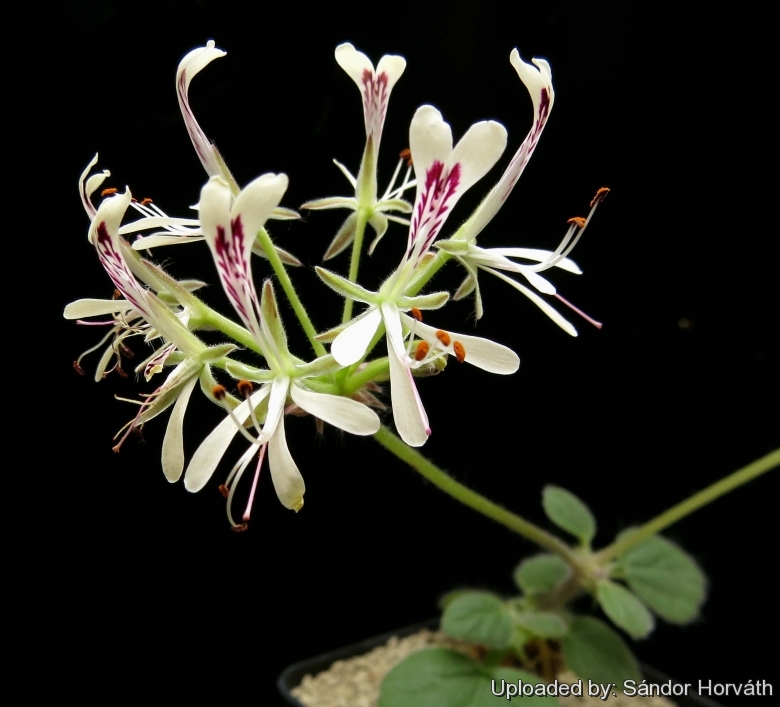




Your support is critical to our success.

Origin and Habitat: Pelargonium curviandrumSN|32376]]SN|32376]] is endemic to a small area from Montagu to Oudtshoorn, Little Karoo in the Southern Cape, South Africa. Extent of occurrence 2500 km², with less than 10 known location.
Habitat and Ecology: This species dwells in the mountains, and grows in the fynbos on sandstone or clay slopes. P. curviandrum is occasionally found growing in the open, but mostly prefers cooler aspects like the protection of other shrub, and avoiding the hot northern slopes of hillsides. P. curviandrum is spring flowering and dormant in summer, it only become visible when the leaves appear during the cooler season. This species is declining due to habitat degradation as a result of ostrich farming, which can be extremely destructive to the natural vegetation especially when ostriches are kept in high concentrations.
Synonyms:
- Pelargonium curviandrum E.M.Marais
Description: Pelargonium curviandrum is a small caudiciform (geophyte) geranium with basal rosette of leaves at ground level and erect flowering stems up to 30 cm tall, growing from an elongated or roundish thick tuberous rootstock. It has large prostrate leaves, that are ovate, more or less notched and covered with short hairs. It produces showy heads of white to cream coloured flowers with red to purple feathery nectar guides on the upper petals.
Tuber (caudex): Elongated or roundish , up to 5 cm in diameter, forming secondary tubers underground with age.
Leaves: In a basal Rosette at the tip of the tuber at ground-level, hysteranthous (expanding after the flowers have opened), simple, green, petiolate, lamina ovate, upper face covered with long glandular hirs and very long soft patent eglandular hairs, lower face velutinous, with long hairs. The margin are more or less deeply crenate, with ample variation in the indentation even at the same locality.
Inflorescences: Branched, part-inflorescence with 7-25 flowers each. Hypanthium relatively long. Petals 5, long and narrowly ligulate to spatulate, white to cream, upper 2 with wine-red feather-like markings, lower 3 narrowly spatulate, white. Fertile Stamen 4, two times as long as sepals, protruding from the flower, curved upwards during anthesis, soon dropped as the stigma ripens. Filament tube white. Anthers orange.
Similar species: Pelargonium curviandrum looks rather like Pelargonium punctatum and Pelargonium triandrum. The leaves and flowers of these three species are very similar. All of them have long, narrow petals and long, protruding stamens which are initially curved upwards, but are dropped as the stigma ripens. They differ in respect of the number of petals and the number of fertile stamens: 5 petals and 4 fertile stamens (P. curviandrum), 4 petals and 3 stamens (P. triandrum) or 5 petals and 2 stamens (P. punctatum).
Bibliography: Major references and further lectures
1) Eggli, U., ed. “Illustrated handbook of succulent plants: Dicotyledons”. 2002
2) Pelargonium curviandrum in: “Cactus and Succulent Journal”, Volume 81, page 56 2009
3) Pelargonium curviandrum in: “The Flowering Plants of Africa” Volumes 54-57 page 39 Botanical Research Institute, Department of Agricultural Technical Services, Republic of South Africa., 1995
4) Vlok, J. and Schutte-Vlok, A.L “Plants of the Klein Karoo”. Umdaus Press, Hatfield.. 2010.
5) Vlok, J.H. & Raimondo, D. 2007. Pelargonium curviandrum E.M.Marais. National Assessment: Red List of South African Plants version 2015.1. Accessed on 2016/01/18
Cultivation and Propagation: Pelargonium curviandrumSN|32376]]SN|32376]] grows on winter rain and heads for summer dormancy. The growing season in northern hemisphere is from September to March. Paying attention to the particular growing requirement of this species is especially important. If you provide it with the right conditions, it will reward you with its unique shape and size. However, this is a tricky plant that is very particular about its growing conditions and require the right maintenance in order to keep happy.
Soil: It does best with a mix that has almost no organic material at all. Perlite can be substituted for pumice, but it tends to rise to the surface of the mixture. It can grows outdoor in sunny, dry, rock crevices (protection against winter wet is required).
Repotting: Avoid to repot frequently. This plant may stay in the same pot for many years.
Fertilization: Be careful not to apply too much fertilizer. Feed it once during the growing season with a fertilizer specifically formulated for cactus and succulents (poor in nitrogen), including all micro nutrients and trace elements diluted to ½ the strength recommended on the label. It thrives in poor soils and need a limited supplies of fertilizer to avoid the plants developing excess vegetation, which is easily attacked by fungal diseases. Ensure a very good ventilation.
Watering: Water from early February to late April, then from early August to late November, at a minimum temperature of +14° C. Keep completely dry in summer and winter, at a minimum temperature of +8° C. Pelargonium curviandrumSN|32376]]SN|32376]] in cultivation is usually so overwatered and overfertilized that it is hardly recognizable as the species that it is. Correctly grown, this is a beautiful, compact and dense plant.
Hardiness: Protect from frost.
Exposure: Light shade or morning sun in summer (avoid direct sun as it grows wild among rocks and under the shade of other plants) and in summer it need to be kept in a cool area.
Reproduction: Pelargonium curviandrumSN|32376]]SN|32376]] can be propagated from seed or dividing the tubers. Plant seeds any time of the year, but a spring or autumn sowing of seeds is usually most successful. Seeds need cool temperature to sprout. Rooting cuttings of stems is another method. Germination can be very erratic, and can take place over a long period of time. There is a way of overcoming the long time periods and the inhibitors; that is, by scarifying the seeds.
| Your Actions | |
|---|---|
| Back to Pelargonium index | |
| Back to Geraniaceae index | |
 |
Back to Succulents Encyclopedia index |
Privacy stantement - Terms and conditions - How to cite - About us - Feedback - Donate




